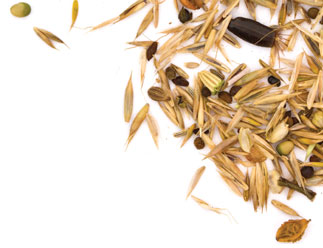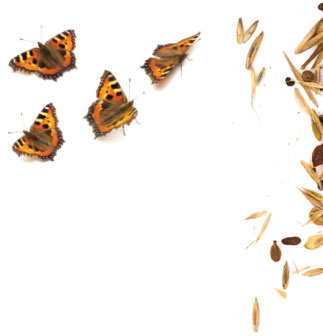 |
|
|
 |
 |
 |
   |
 |
|
No. 9 - THE OLD FOREST
|
 |
|
The field
in front of you is called Side Hill for boringly obvious
reasons! Along the top third of this field the soil
is very thin and chalky.
|
 |
|
Heath Grassland
|
 |
 |
 |
|
The thin, chalky, infertile soils
towards the top of Side Hill were very difficult to
farm viably (particularly with the large number of rabbits
coming out to dinner from the rifle range) and so we
planted it with a chalky downland mixture of fine grasses
and wildflowers, with assistance from our Environmental
Stewardship grant. The seed was mainly harvested from
(near) Royston Heath by Emorsgate Seeds www.wildseed.co.uk.
A hay cut is taken from this small meadow in late July
and the re-growth (aftermath) is grazed by sheep in
late summer and autumn.
It attracts masses of butterflies and is hunted over
by our Barn Owls.
|
 |
|
Wild Bird Seed Mix
|
 |
 |
 |
|
Around the farm, a number of small,
awkward field corners have been taken out of the normal
arable rotation and sown with a range of small seeded
plants (millet, kale, sweet clover etc) to provide winter
feed for our small song birds. The scruffy plot behind
you is one such of these.
Small birds have three crucial requirements:
|
 |
|
•
|
summer food to raise their
broods (usually insects, which as an organic farm,
we provide in abundance!)
|
 |
|
•
|
good nesting sites (usually
a variety of different hedgerows like ours, although
some are ground nesting)
|
 |
|
•
|
winter food (usually seeds
- which is what these small plots are designed
to provide!)
|
|
 |
|
They also like an absence of predators,
but that is a more difficult, moral issue.
|
 |
|
Laid Hedge
|
 |
 |
 |
|
The hedge running away to your left,
beside the bridleway, was laid during the 2007 East
Anglian Hedge Laying Competition (approximately the
first 200 yards only), having previously last been coppiced
in 1974. It is home to many small birds (Corn Bunting,
Yellowhammer, Hedge Sparrow etc).
|
 |
|
Permissive Footpath
|
 |
 |
 |
|
The footpath you have just walked
along is one of several that we have established, linking
existing rights of way, to create a circular path through
the farm. Hopefully enabling you to enjoy the farm as
we do.
|
 |
|
Old Forest
|
 |
 |
 |
|
The field on top of the hill is called
the Old Forest. This probably alludes to a time when
most of the heavy clay lands were too difficult to farm
and therefore remained as ancient woodland. Sadly, now
long gone.
|
 |
|


 |
|
 |
|
